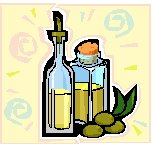 Facts about fats
Facts about fats
The word fat is the most misunderstood term. A majority of people, especially those trying to lose weight believe in avoiding all dietary fats at all costs. Many know that it is calorie dense but not many know that fat is an essential nutrient like carbohydrates, proteins, vitamins and minerals for overall health. Fats provide 9 calories per gram and are the most concentrated source of energy while carbohydrates and proteins provide 4 calories per gram.
The fat in foods is referred to as Lipids and is made up of carbon, hydrogen and oxygen. They exist in three forms –Oils (liquid at room temperature), Fats (solid at room temperature) and Waxes.
There are many types of fats and they all differ in their characteristics. There are good fats that promote good health and bad fats that can increase ones risk for chronic diseases.
Never go on a fat free diet as many important functions of the body are compromised by doing so.
The healthy fats are known as unsaturated fats (mono and poly unsaturated) and the bad fats are known as saturated fats or transfats.
The unsaturated fats help to lower heart diseases by reducing the low density lipoproteins (LDL) and cholesterol and help in raising the high density lipoproteins (HDL). They also improve Insulin sensitivity and blood pressure.
Saturated fats on the other hand, promote heart diseases, certain cancers, obesity and diabetes. These fats elevate the LDL cholesterol and triglyceride levels and can also aggravate arterial inflammation. High levels of these bad fats tend to lower the healthy HDL levels too.
Saturated fats or unsaturated fats refer to the number of hydrogen atoms attached to the carbon atoms. These carbon atoms form the backbone of the fat molecule. When the carbon atoms are linked to the hydrogen atoms on both sides the fatty acid is termed saturated. If one or more carbon atoms are free (not linked to hydrogen atoms), it is termed unsaturated. The degree of saturation varies widely. The more hydrogen atoms a fat has the more saturated it becomes. Unsaturated fats are of two types called Mono unsaturated and Poly unsaturated.
Examples of unsaturated fats:
Mono unsaturated fats include olive oils, peanut oils, canola, mustard seed oil, soyabean oil, and avocado. They are considered to be the best kind of fats for healthy body, heart and mind. This type of fat tends to lower "bad" LDL cholesterol while leaving the "good" HDL cholesterol unchanged.
Poly unsaturated fats include corn oil, safflower, seeds, vegetable oils, flax seed oil, tuna, sardines and walnuts. This type of fat tends to lower both "bad" LDL and "good" HDL cholesterol.
Examples of saturated fats are animal fats, butter, vegetable oils like palm and coconut, cream, whole milk, processed foods like chips and cookies.
 Examples of Tran’s fats are margarine, baked foods like biscuits, cookies, pastries, cakes and crackers and other fried snacks. Trans-fatty acids increase "bad" LDL cholesterol and lower "good" HDL cholesterol, which may increase heart disease risk.
Examples of Tran’s fats are margarine, baked foods like biscuits, cookies, pastries, cakes and crackers and other fried snacks. Trans-fatty acids increase "bad" LDL cholesterol and lower "good" HDL cholesterol, which may increase heart disease risk.
Dietary fat and its importance.
- They are carriers of fat soluble vitamins like A, D, E and K.
- They supply essential fatty acids like Linoleic and Linolenic fatty acids. (our bodies cannot manufacture these essential fats and so they must be provided by the foods we eat).
- The essential fatty acids are important for proper growth, maintenance of healthy skin and hair, maintaining cell membranes, regulating cholesterol metabolism, and manufacture of hormones like Prostaglandins and Eicosanoids which help to regulate heart function and blood pressure and is an important component for anti ageing.
- Fats also provide a cushioning effect for most of our vital organs.
- Fat is an energy provider. But only moderate quantities are advocated.
Avoid transfats
Trans-fats are made by adding hydrogen to vegetable oils through a method called hydrogenation which causes the oil to solidify and it increases the flavour, shelf life and stability of the foods containing it. This is a common ingredient in almost all deep fried snacks and foods like fast foods, cakes, pastries, doughnuts, cookies, biscuits, potato chips, samosas, salad dressings and others.
Some common examples of trans fats are Dalda, Margarine, Nutralite and all types of low fat butters available in market.
Both trans-fats and animal fats are detrimental to health as they bring about free radical formation. They hasten the onset of diseases like cancer of the breast, colon cancer, heart diseases, atherosclerosis, diabetes and other degenerative conditions. They are difficult to digest and they lower your good cholesterol levels.
Here are a few recommendations to help you reduce your fat intake:
- Choose low fat milk and its products.
- Include plenty of vegetables, fruits, raw vegetables, whole grains, beans and peas. They are antioxidant reservoirs and help to prevent formation of free radicals that damage the cells.
- Include nuts like walnuts, almonds, hazel nuts and peanuts.
- Choose salad dressings with cold pressed virgin oils, Tahini and Hummus. Research has shown that eating olive oil daily can cut the risk of breast cancer by about 30 percent.
- Use refined vegetable oils for cooking instead of dalda, vanaspati etc. Use just about 2 to 3 teaspoons daily.
- Cut out animal fats like cheese, full fat milk, red meats etc. They hasten the onset of diseases and also accelerate ageing.

- Have more omega-3 fatty acids which are found in walnuts, wheat germ oils, flax seed oil and soyabean oil. Non vegetarians can choose fish like tuna, sardine and mackerel for omega-3 fats. Avoid deep frying of the fish.
 Indulge in regular exercise like walking, swimming, yoga to burn of the extra calories form fat and maintain a healthy well being.
Indulge in regular exercise like walking, swimming, yoga to burn of the extra calories form fat and maintain a healthy well being.
Follow these guidelines to help you differentiate between the healthy and unhealthy fats. The best ways to cook are steaming, roasting, stewing and stir frying where minimum oil is required.